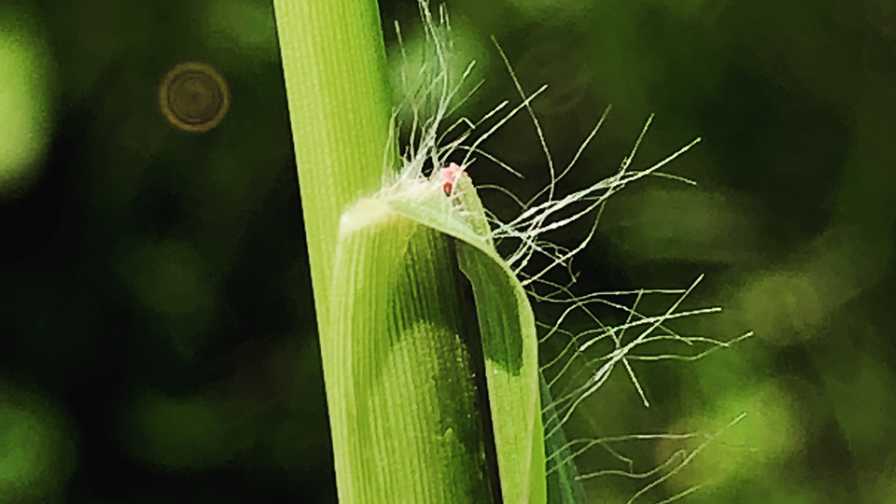Field Scouting Guide: Yellow Foxtail

Leaves of yellow foxtail are glabrous (smooth), except for long, white, and wavy hairs on the upper surface near the base of the blade (close to the collar). Photo by Lynn M. Sosnoskie
This edition of “Field Scouting Guide” concentrates on yellow foxtail.
Lynn M. Sosnoskie from Cornell University is our expert and teaches you how to spot and treat this weed.
BASICS
· Scientific name: Setaria pumila (formerly Setaria glauca)
· Common name: Yellow foxtail (sometimes golden foxtail)
· Geographical range: It is native to Europe but has a worldwide distribution. It can be found in the lower 48 United States, Hawaii, and most of Canada.
· Crops affected: Agronomic and vegetable crops, turf, ornamental plantings are most affected; it usually prefers full sunlight environments.
PEST IMPACT
Crops are most sensitive to competition during the establishment phase. Dense foxtail populations interacting with newly emerged seedlings or young transplants can significantly impact crop development and potential yield.
Yellow foxtail produces a larger seed as compared to other foxtails (green and yellow), which may make its seedlings more vigorous and competitive at emergence.

Flowers of yellow foxtail are held in narrow and dense panicles (present from late summer to fall); golden bristles help to distinguish the species. Photo by Lynn M. Sosnoskie
IDENTIFICATION
Yellow foxtail is an upright summer annual grass that grows in clumps. Leaves are glabrous (smooth), except for long, white, and wavy hairs on the upper surface near the base of the blade (close to the collar).
The ligule (located at the junction of the leaf blade and sheath) consists of a fringe of short hairs.
Flowers are held in narrow and dense panicles (present from late summer to fall); golden bristles help to distinguish the species.
Yellow foxtail seeds germinate, and seedlings emerge from late spring to mid-summer.
Yellow foxtail can be difficult to distinguish from both green foxtail (Setaria viridis) and giant foxtail (Setaria faberi), especially at the seedling stage. Each of the foxtail species have hairy ligules. The leaf sheath margins of giant foxtail and green foxtail are hairy, while that of yellow foxtail is not. The leaves of green foxtail are hairless, while giant foxtail produces hairs on the leaf blades; yellow foxtail is hairless except for the wavy hairs found near the collar.
The species also differ with respect to their flower heads; giant foxtail is the largest, followed by green foxtail, which can be nodding. The head of yellow foxtail tends to be stiffer than other foxtails and more erect, in my experience, and is golden in color.
RECOMMENDED TREATMENT
The herbicides you elect to use will depend on the crop you are currently growing, as well as crops that you intend to produce in the future (because of plant-back restrictions). There are multiple pre-emergence, soil-applied, or preplant-incorporated herbicide active ingredients with activity against foxtail species including: bensulide (Prefar, WSSA 8), pendimethalin (Prowl H2O, WSSA 3), S-metolachlor (Dual Magnum, WSSA 15) and trifluralin (Treflan, WSSA 3). These products must be applied in advance of foxtail emergence as they will not control plants that are actively up and growing.
Some short-lived residual herbicides may break before the emergence window of yellow foxtail is completed, and growers must be prepared to handle escapes. With respect to post-emergence products, The WSSA 1 herbicides (the “fops” and the “dims”) are grass-specific with respect to their selectivity. This includes clethodim (Select) and sethoxydim (Poast). These are systemic herbicides and should be applied to actively growing grasses that are not stressed by heat or drought.
Obviously, this list is not inclusive, and other pre- and post-emergence herbicides are available, depending on your production system. Discuss your options with your crop consultant or local county agent and always read and follow the labels.
Growers using flaming to suppress weeds should be aware that the growing point of grasses is relatively protected, and regrowth can occur following treatment; better results will be achieved when targeting smaller plants. If mowing is an option, this strategy can be used to eliminate seed production. Seeds may remain viable in the soil for over a decade, and repeated management strategies will be necessary to reduce the size of the soil seed bank.










